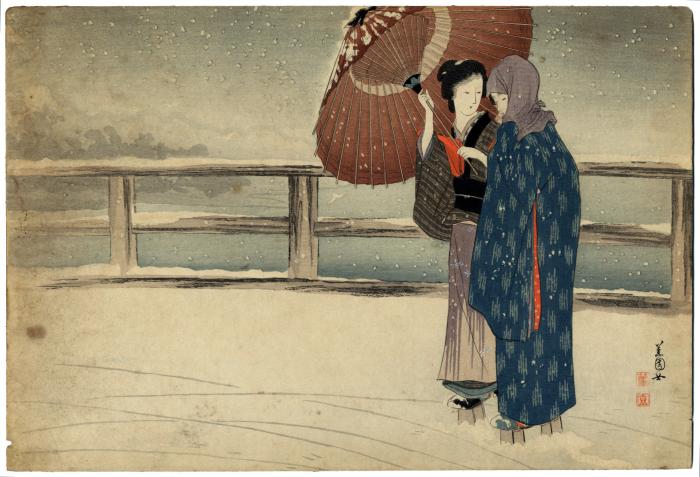Ikeda Shōen (池田蕉園) (artist 05/13/1886 – 12/01/1917)
Sakakibara (original family name - 榊原)Ikeda Yuriko (family name - 池田百合子)
Links
Lyon Collection - Ikeda Terakata biographyBiography:
Ikeda Shōen 池田蕉園 was born Sakakibara Yuriko in the Kanda section of Tokyo. Her father had studied at Keio University and at Rutgers University in New Jersey. Both her parents spoke English. Her mother studied Western style oil painting. After her father returned from the United States in the late 1880s, he rebelled against everything Western, in keeping with the trend among Japanese intellectuals. Her mother abandoned Western-style clothing and the study of oil painting and returned to a traditional Japanese lifestyle.
Yuriko often visited shops where she became familiar with ezōshi (picture books) and prints by Kobayashi Kiyochika and Tsukioka Yoshitoshi. At Fujimi grade school she was a classmate of Tsuzuki Teru who became the wife of Kaburaki Kiykata. In her early teen years, Yuriko attended Joshi Gakuin, a progressive women's high school, where she learned English and read English authors, including Shakespeare. There's a story that while Yuriko was at Joshi Gakuin, a teacher saw her drawing during Bible class but found the picture so good that she didn't scold her. After the family moved to Kami Negishi, a suburb of Tokyo, Yuriko could no longer attend Joshi Gakuin and spent her time painting and reading novels by Izumi Kyōka. She became a member of his fan club, and he wrote a haiku in his honor at his death.
She began studying with Mizuno Toshikata in 1901. Toshikata gave her the art name Shōen, taking the character shō from his own gō (artist name) Shōsetsu. He chose the name Shōen because the Kyoto woman painter Uemura Shōen (1875 - 1949) was enjoying considerable success.
At Toshikata's school, Shōen met and fell in love with a young painter, Ikeda Terukata. She was of a higher social class and different background than Terukata. Although her family was opposed, she and Terukata became engaged in July, 1903. Later that year, Terukata disappeared with Sugitani Shōran, a woman twenty years older than he. Terukata was about twenty years old at the time, and Shōen was about seventeen. She was very upset and didn't paint for some time.
From 1903 she was a member of Cormorant Society and by 1906 was painting again and drawing illustrations regularly for the magazine Girl Students' World (Jogaku sekai). In 1908 Toshikata died and the long-absent Teukata reappeared at his funeral. in 1909 Shōen entered the school of Kawai Gyokudō, where Terukata was already a student. Shōen also received instruction in drawing the human figure from Suzuki Kason. During the period between 1906 and 1909 her work, which she exhibited with Society for Refinement of National Painting and Bunten, was at its peak. Most of her paintings from this period were destroyed in a fire or have otherwise disappeared.

Terukata & Shōen on honeymoon
at the home of Chuo Negishi (中根岸)
She and Terukata were married in July 1911. It is reported that after the marriage she devoted her major energies to support of Terukata's career and passed commissions that were offered to her on to him. Nonetheless, she exhibited at Bunten and won a total of nine Bunten awards over the years. She also exhibited with Tatsumi Painting Society and at Inten, the first reorganized Japan Art Institute exhibition, in 1914. In January 1917 Ikkeda Shōen developed tuberculosis. She died of the disease in December of that year.
Shōen's kuchi-e include a few nishiki-e for Shun'yōdō books and two in Bungei kurabu in 1913. Her most important nishiki-e were in the print series Young Beauties in Layered Mist (Yaigasumi) (Kokkeidō, 1906). She also contributed illustrations to the magazines New Novels (Shinshōsetsu), Girls' World (Shōjo sekai), Girls' Pictorial (Shōjo gahō, and Family Magazine (Katei zasshi).
From: Woodblock Kuchi-e Prints: Reflections of Meiji Culture by Helen Merritt and Nanako Yamada, University of Hawaii Press, 2000, p.196-7
